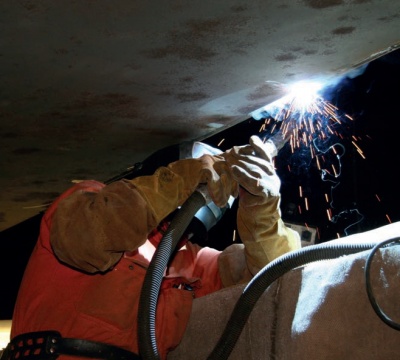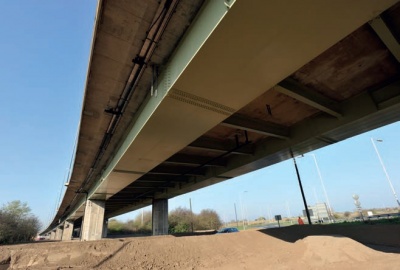M53 Bidston Moss Viaduct strengthening
Structural Steel Design Awards 2012 - Award
The 730m multi-span box girder viaduct connects the M53 to the Kingsway Tunnel under the River Mersey and carries 63,000 vehicles daily on this strategic route to Liverpool. The viaduct was facing closure if not strengthened.
The complex project involved numerous innovative design solutions and 100km of new weld in extremely confined space conditions to strengthen and restore the viaduct to full network capacity, whilst maintaining live traffic at all peak times on the M53. The 100-week construction phase also included follow-on refurbishment activities including re-painting, drainage, lighting, cathodic protection and other highway works. To protect the road user, workforce and environment, 3.7km of box girder was housed within bespoke scaffold containment.
The main criterion for the design was to ensure strengthening work could be completed with minimal disruption to the road user. As such, most of the strengthening work was carried out inside the boxes and external faces of the box. A staged sequence was used minimising potential weakening of the structure due to drilling holes, cutting out large holes, applying heat to the structure and removing existing welds, which did not reduce the structural capacity of the structure significantly, allowing withstanding of the load effects from the interim loading.
The detailed structural surveys and analysis during the initial Phase A design period developed strengthening solutions bespoke to the project. With 604 unique boxes to be strengthened, the team developed specific solutions to suit requirements minimising the overuse of materials, maximising efficiency and steelwork techniques guaranteeing the 80-year design life.
It was recognised during the early stages that access through the structure was a serious health and safety concern due to the extreme confined spaces. A business case put forward demonstrated that by enlarging the 602 openings this would significantly reduce risk to the programme and budget, giving greater certainty to the scheme outturn. This resulted in a £6.016m target cost being approved in advance of the main works, saving a proposed £1.9m with a two week programme saving; the actual saving was £6.1m and 12 weeks' early completion.
A full-time permit control and bespoke rescue team was maintained on site during all working periods who could respond and be at the scene of any incident within the extreme confined spaces in less than five minutes. Throughout the project, a full emergency and fire plan was maintained and several mock rescues and fire training events were held with the local fire department.
Working as an integrated team the number of solutions required was reduced to achieve the required strength. A number of value engineered solutions were completed - a good example of this was the strengthening of cross girder connections resulting in a saving of £700k.
Steel strengthening was utilised as it is compatible with the existing steel material. By strengthening the existing structure, this mitigated full replacement at a potential further cost of over £100m and reduced the embodied carbon by 85%, notwithstanding traffic disruption caused through taking a key strategic route into Liverpool offline. Steelwork allowed significant flexibility in design and construction, as well as reduced future maintenance costs when whole life cost is considered. Through the lightweight nature and unique installation methods utilised on the viaduct the project was able to limit the loading transmitting to the existing foundations.
The steelwork scope involved strengthening 3,900 linear metres of existing box corner welds both overhead and down hand, some 32,500 retrofit shear pin connectors enhanced the longitudinal shear transfer capacity of load from reinforced concrete slab to steel box. 140,000 holes required drilling in up to four plies worth of steel using close tolerance steel drilling which allowed the completion of holes at a diameter of 20mm within tolerance of ‐0.00mm + 0.15mm. To install over 565 tonnes of steel, 26,200m of finished weld was completed using highly specialised labour, varying between 1 and 14 runs, in excess of 100km.
Through utilising a bespoke containment system steelwork installation could progress seamlessly. The strictly controlled environment allowed first class application of corrosion protection paint utilising innovative equipment, currently the only project to be using such equipment. A reduction of 99% of harmful fumes from painting operations delivered significant sustainable solutions.
With the entire site striving for continual improvement a true 'Lean Culture' was seen on the project which meant a drive to remove waste from processes and ensure smooth flow. Over 16 'Lean' improvements were delivered which represented a total saving of over £2.5m.
Through extensive engagement and flexibility of the steelwork installation significant savings were achieved. Of the original target cost of £25m through the installation of 387 tonnes of steel, a final 565 tonnes of steel was installed at a cost of £16.8m. This exceptional result was achieved through the extensive collaboration, integration and continual strive to optimise all solutions.
| Structural Engineer | Amey |
| Steelwork Contractor | Cleveland Bridge UK Ltd. |
| Main Contractor | Costain |
| Client | Highways Agency |
Judges' comments
The original bridge structure was executed by a shipbuilder in the 1970s, and this is the third exercise to strengthen it to current standards. The work of the designer and steelwork contractor has been outstanding in investigating, analysing and executing the strengthening throughout the 3km length.
Successfully and safely undertaking the extensive heavy welding inside the very confined boxes presented extraordinary challenges.






